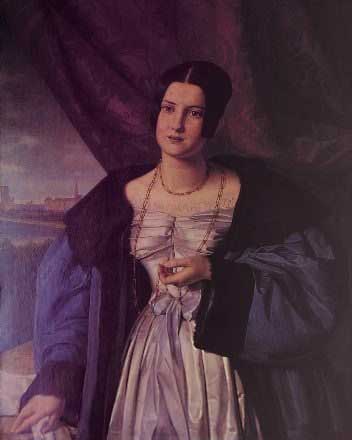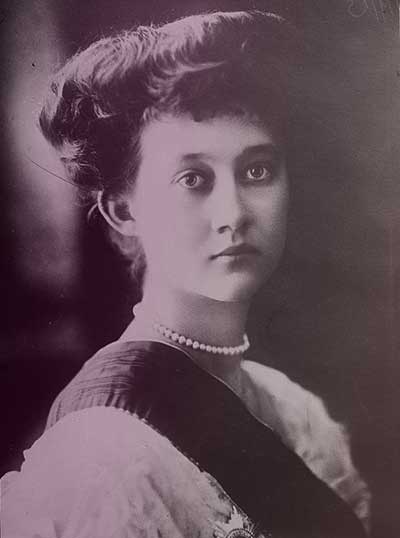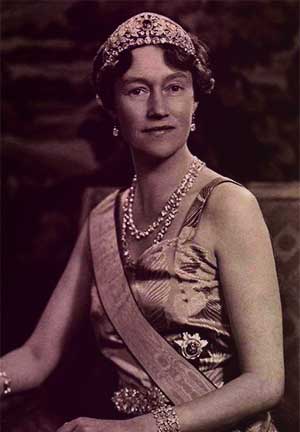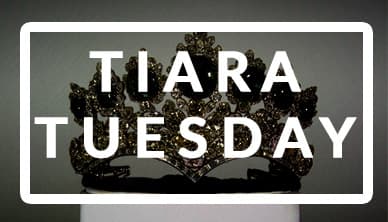Share this Post
Made with diamonds set in white and yellow gold, the Grand Duchess Adélaïde tiara features a removable cushion-cut sapphire in its center. The diamond motifs are leaves and berries crafted of brilliant-cut and rose-cut diamonds. There’s also a removable row of big-ass diamonds along the base, for those times when you need to let people know you mean business. Here’s what it looks like on the present Grand Duchess of Luxembourg:
No one knows who made it or when, but it’s usually called the Grand Duchess Adélaïde Tiara after the grand duchess who wore it frequently during her brief reign in the early 1900s. The tiara probably dates back to the mid-19th century. There are two main possibilities for its origin, which also have to do with how Luxembourg separated from the Netherlands.
A Teensy Bit of Background
Since 1815, the Grand Duchy of Luxembourg had been a satellite state of the Netherlands. The reigning monarch of the Netherlands was also the Grand Duke of Luxembourg. In 1890, however, the throne of the Netherlands passed to Princess Wilhelmina, the only daughter of King Willem III. That was a no-go for Luxembourg, where the Salic Law was still on the books. The Salic Law excludes women from the succession, which meant Wilhelmina couldn’t rule Luxembourg, too. They had to find the next available male relative and bring him in to take over the duchy. That next available male relative was Adolf, Duke of Nassau, who became the first Grand Duke of Luxembourg in 1890.
Tiara Origin Possibility #1

It belonged to Adolf’s first wife, Grand Duchess Elizabeth Mikhailovna of Russia, a niece of Tsar Nicholas I (shown at right). Nicknamed “Lilli,” she was just 17 when she married the 26-year-old Adolf. Romanov brides usually come draped in an assload of jewels, but Lilli didn’t have much of a chance to show hers off. She died a year after the wedding, giving birth to a stillborn daughter. Adolf built a church to bury her in, high on a hill that would always be visible from his castle. What makes people think this tiara might have been hers? It’s a kokoshnik shape, which is traditionally Russian in origin. Kind of a weak theory, I know.
Tiara Origin Possibility #2
It belonged to Adolf’s second wife, Princess Adelheid-Marie of Anhalt-Dessau. Although not as wealthy as a Romanov bride, Adelheid-Marie would have also brought a trousseau that might have included this tiara. Supposedly, she was documented wearing the tiara, but that doesn’t necessarily prove it was hers. I mean, if your husband’s dead first wife left this behind, would you let it gather dust? I think not.
In any case, the first Luxembourg royal to really be associated with this tiara was Grand Duchess Marie-Adélaïde, granddaughter of Adolf and his second wife, Adelheid-Marie. Aren’t you just blown away by their creative naming patterns here? But here’s where the plot thickens.
Screwed over by Germany, Take 1
Remember how Adolf got to be grand duke in the first place – because the Dutch king only had a daughter? Well, Adolf’s son, William IV, had six daughters and no son. Ouch. This time, logic prevailed and William simply named his eldest daughter, Marie-Adélaïde, his heir. Isn’t she a peach?

When William died in 1912, Marie-Adélaïde became Grand Duchess at the age of 17. A year later, when she was officially sworn in at age 18, she said: “The growing economic inequality between men is the greatest worry of our age. Social peace, no matter how ardently desired, remains to this day an elusive ideal. Is it not necessary to work on reconciliation and solidarity?”
The growing economic inequality between men is the greatest worry of our age. Social peace, no matter how ardently desired, remains to this day an elusive ideal. Is it not necessary to work on reconciliation and solidarity?
Grand Duchess Marie-Adélaïde of Luxembourg
I don’t envy Marie-Adélaïde. You’re 18 years old, at least nominally in charge of a country (albeit a small one), and the clouds of World War I are gathering on your horizon. It’s a shit sandwich, and she got stuck in the middle of it.
As soon as war broke out, the Germans invaded, violating Luxembourg’s neutrality. Marie-Adélaïde made a formal protest, but decided to remain neutral instead of fighting. When the kaiser visited Luxembourg, she hosted him at the palace – and this really pissed people off. Diplomatically, I don’t think she had much choice, but this meeting became a constant source of bad PR. The press called her a sympathizer, and the French refused to have anything to do with her. In fact, their government issued a statement calling her “gravely compromised.” Belgium joined the list of countries mad at Marie-Adélaïde, but both France and Belgium had ulterior motives – they wanted to annex Luxembourg for themselves. The fastest way to do that was to get rid of Marie-Adélaïde by making her seem like a terrible leader.
Terrible or not, the poor Grand Duchess was swamped by bad press and calls for her abdication. It didn’t help that one of her sisters, Princess Antonia, got engaged to the Crown Prince of Bavaria – a Field Marshal in the German army, who had just helped push the French back at the Battle of Lorraine. That must have made for some uncomfortable dinner conversions.
There comes a point where you can’t fight fate. In January of 1919, Marie-Adélaïde abdicated in favor of her younger sister, Charlotte. Before she left, she divided her jewels and possessions among her sisters. This tiara went to Charlotte. Marie-Adélaïde left the country and became a nun in Italy. Bad health forced her to leave the convent, and she went to Bavaria, where she died of influenza in 1924 at the age of 29.
Screwed over by Germany, Take 2
Okay, so you’ve just seen your sister railroaded out of her own country…and now it’s your job not to repeat her mistakes. What do you do?

Charlotte’s first step was to get married. It’s a smart choice – the sooner you have kids, the sooner you guarantee the succession and amp up your possibilities for good PR. Charlotte chose a cousin, Prince Felix of Bourbon-Parma. The good news? He’s not German. The bad news? He’d fought for Austria, Germany’s ally in the war. This was a dicey choice for Charlotte, and their wedding was carried out hastily and mostly in secret. Click here to see them on their wedding day. They had a son, Prince Jean, which secured the succession. Seeing him must have made them sigh in relief after the estrogen overload of the previous generation.
But much like her sister, Charlotte was about to get bitch-slapped by the specter of war and there was nothing she could do about it. The Nazis, who didn’t give two shits about Luxembourg’s neutrality, invaded on May 9, 1940. Charlotte and her family fled to France. They weren’t safe, though, because France surrendered to the Nazis just a month later. Charlotte fled again, this time through France and Spain to Portugal, where her mother had been born an Infanta.
But much like her sister, Charlotte was about to get bitch-slapped by the specter of war and there was nothing she could do about it.
The Germans reached out to Charlotte and offered to restore her to her throne. Charlotte remembered very well what had happened to her sister when people suspected her of German sympathies, so she told the Nazis to go fuck themselves. She mounted a charm offensive, traveling to London, Canada, and the U.S. She went on air through the BBC to offer messages of support to the people of Luxembourg, who were now fully under German control. When the war ended, people remembered her very public stance against the Germans and welcomed her back with open arms.
Wanna know how she celebrated? By putting that big-ass row of diamonds on this tiara. Okay, so I’m not actually sure that’s how she celebrated, but it’s how I would have celebrated, and we do have this nifty picture of the tiara with the extra diamonds.
The Luxembourg royal family didn’t escape the war unscathed. Remember Charlotte’s younger sister, Antonia, the one who married the Crown Prince of Bavaria? The Nazis pushed hard for her husband, Rupprecht, to join them. He refused. When push came to shove in 1939, they fled Germany for Italy.
At first, they were guests of the Italian royal family. But they eventually settled into their own routine in Italy, with the kids in school and Antonia spending lots of time near the Alps. All went well until 1944, when a group of German aristocrats and military officers failed to kill Hitler (yep, this is the subject of the Tom Cruise movie Valkyrie). Hitler went ballistic, and killed or imprisoned as many aristocratic opponents as he could find. Borders, schmorders, said Hitler. Antonia and the kids were rounded up in Italy, although Rupprecht escaped by going into hiding.
Antonia ended up in a prison hospital, while her kids were shipped off to Sachsenhausen and later moved to Dachau in April of 1945. They survived, but Antonia was broken by the experience. She swore she’d never live in Germany again. She moved to Switzerland and died nine years later, her health pretty much ruined by the torture and the generally shitty conditions of her prison hospital.
What Happened to This Tiara?
It’s still with the royal family. In 1964, Grand Duchess Charlotte abdicated in favor of her son, Jean. He married a Belgian princess and reigned as grand duke until his abdication in 2000. These later abdications aren’t because of any political turmoil – it just seems like the family knows when to step aside for the next generation. Today, Jean’s son rules as Grand Duke Henri, with his wife, Grand Duchess Maria Teresa, who has worn this tiara (that’s her in the Getty embed at the top, during a state visit to Sweden in 2008). I don’t think I’d have worn this tiara with a dress that color or lipstick that color, but what do I know, I’m just a peasant. On the plus side, I have a rhinestone necklace that looks just like this, only smaller.
Bonus Texas Connection
What the hell does Luxembourg have to do with Texas? I’m so glad you asked.
In 1842, a group of noblemen, including the future Grand Duke Adolf, founded the Society for the Protection of German Immigrants in Texas. In 1843, they bought a 4,428-acre ranch in Texas for .75 cents an acre and named it the Nassau Plantation, after the duke’s family. The idea was that the plantation would be a good starting point for German immigrants bound for the West. Sounds great, right? Well, this was pre-Civil-War and Texas was a slave state. One of the Society’s officers, Count Boos-Waldeck, went out bought slaves in New Orleans, Galveston, and Houston to grow cotton. When in Rome, right?
Well, in 1844, the Society’s commissioner general, Prince Carl of Solms-Braunfels, came to inspect the property. He didn’t like the fact that they’d gotten involved with slavery, and he didn’t like the fact that the plantation was surrounded by other tracts managed by non-Germans. For some reason, he thought being surrounded by non-Germans would force the new immigrants to lose their culture. (Um, you’re in America, dude. The whole place is full of immigrants with different backgrounds and cultures. Get a friggin’ grip.) Anyhoo, the Society could never really get their act together and the plantation never really became much of anything. Most of the settlers who arrived there left soon after. After a few years, the only ones left on Nassau Plantation were the aristocrats sent to manage it.
Solms-Braunfels thought being surrounded by non-Germans would force the new German immigrants to lose their culture. (You’re in America, dude. The whole place is full of immigrants with different backgrounds and cultures.)
In 1848, the Society went bankrupt. It sold the plantation, which was divided into smaller farms, some of which were bought by the original German immigrants who settled nearby. There’s nothing left of the plantation today, but you can go see the historical marker just outside Round Top, Texas.
How Would I Wear It?
Okay, back to the tiara. I really love this one. The symmetrical design, the gracefully pointed arch at the top, the show-stopping power of the sapphire – it’s grand without being overwhelming. It’s the perfect tiara for traveling because you can bring along that extra row of diamonds for the bottom in case something super-formal comes up or you just generally need to kick some ass.
I’d wear this on a cruise. All day, every day, on the beach, on a jet ski, on a shore tour. The sapphire is made to be worn in a landscape saturated with blue. Then, for dinner, I’d slap on the extra row of diamonds. Maybe you could even mix it up and wear those diamonds as a necklace – I’m not sure, but that would be awesome, too. Pack once, wear everywhere. That’s just smart design.
And that’s the Grand Duchess Adélaïde tiara!
Want to suggest a tiara? Drop its name or a photo link into the comments. I’ll do my best to find something interesting in its history for a future Tiara Tuesday.
Image credits:
Lilli: Painting by an unknown artist, public domain via Wikimedia Commons
Marie-Adélaïde: By Bain News Service, Public domain, via Wikimedia Commons
Charlotte: MisJoyasRealas.blogspot.com

Love Royalty and Tiaras?
You might like my other site, The Girl in the Tiara. I created it to write about amazing royal women and their tiaras. It’s like Drunk History meets The Crown.

Tiara Tuesday Archives
Visit the archives to read about more royal shenanigans. And by shenanigans, I mean war, revolution, betrayal, lust, murder, diamonds, and Princess Stéphanie’s chafing dish.
Tell the World

Comments
http://artemisiasroyaljewels.blogspot.com/2013/02/the-isenburg-family-tiara-and-princess.html Here are some more that you might be interested in.
Thanks for the link! I love a good meander tiara – theirs is so tall and grand! Will have to see what I can dig up on this one… 🙂
I’m very curious about the tiara in the image below, worn by Sam Godsal. I’d love to learn more. There’s so much more out there about royal tiaras than noble ones.
http://www.tatler.com/bystander/events/2015/may/the-best-tiaras-in-bystander#!/17610/image/12
I’ll see what I can dig up – I’m finishing up a book right now, but this is a worthy distraction! I love the look of this tiara. What a graceful shape.
We have been celebrating Tiara Tuesdays for nearly 15 years. I had a nasty client (a bank) that I had to visit every Tuesday for 4 years, they were awful, mean spirited bullies and there were many tearful car rides home. After a couple of years, we “invented” Tiara Tuesdays to change the story. I’d get up, place my (imaginary) Tiara on at a delightfully jaunty angle and head off to the wretched bank. Every week. And it helped! I’d hold my head high, find my royal detachment and elbow, elbow, wrist, wrist, touch the pearls at the mean peasants.
Thankfully I will never again have to step foot in that bank, but Tiara Tuesdays live on in my house, a celebration of overcoming the pettyness and rising above it all.
Simply delighted to run across you Tiara Tuesday page as I obsess over Princess Eugenie’s wedding ensemble.
I wore a replica of this tiara on my wedding day. Sapphire is my birthstone and my engagement ring is an oval sapphire with a halo of diamonds around it – Like Princess Diana’s (now Kate’s) engagement ring. Though theirs is about 12 carats and mine is only 2 carats. Too bad I’m not a royal.